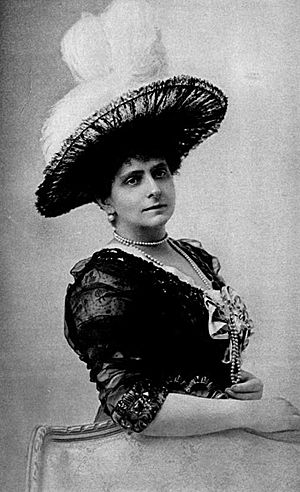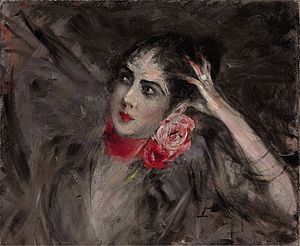Catherine Radziwill facts for kids
Quick facts for kids Princess Catherine Radziwiłł |
|
|---|---|
 |
|
| Spouse(s) |
Prince Wilhelm Radziwiłł
(m. 1873; div. 1906)Karl Emile Kolb-Danvin
(m. 1909, died) |
| Issue | |
|
|
| Full name | |
| Ekaterina Adamovna Rzewuska, Princess Radziwiłł, Mrs. Kolb-Danvin | |
| [[]] | Radziwiłł |
| Father | Adam Adamowicz Rzewuski |
| Mother | Anna Dmitrievna Dashkova |
| Born | 30 March 1858 Saint Petersburg, Russian Empire |
| Died | 5 December 1941 (aged 83) New York City, U.S. |
Princess Catherine Radziwiłł (born March 30, 1858 – died May 12, 1941) was a famous Polish-Russian noblewoman. She was born in Russia into the Polish-Lithuanian House of Rzewuski. Her mother's family was the well-known Russian Dashkov-Vorontsov family. In 1873, she married Prince Wilhelm Radziwiłł from Poland-Lithuania.
Catherine was a well-known person in the royal courts of Germany and Russia. She loved the fancy life of the courts, social events, and sharing interesting stories. She also had a talent for writing. She wrote many books about European royalty and the Russian court. Some of her famous books include Behind the Veil at the Russian Court (1914) and her own life story, It Really Happened (1932).
Contents
Family and Early Life
Princess Catherine Radziwiłł was born in St. Petersburg. Her birth name was Ekaterina Adamovna Rzewuska. She belonged to the House of Rzewuski, a Polish family known for its warriors and leaders. Catherine was the only child of Russian General Adam Adamowicz Rzewuski. He fought in the Crimean War. Her mother was Anna Dmitrievna Dashkova. Anna was the daughter of Dmitry Dashkov, who was a minister for Tsar Nicholas I.
Catherine's mother came from some of Russia's most important families. Sadly, her mother died when Catherine was born. Her father later married again and Catherine gained three half-brothers. One of them, Stanislaw Rzewuski, became a writer. Catherine's family had many famous writers. These included her great-great-grandfather, Wacław Rzewuski, and her uncle, Henryk Rzewuski. Her aunts, Ewelina and Karolina, were also well-known. Ewelina was married to the famous writer Honoré de Balzac.
Catherine grew up on her father's large estates in Ukraine. Her father was very strict. Even though her family was from the Polish–Lithuanian Commonwealth, Catherine felt more Russian than Polish.
On October 26, 1873, when she was just 15, she married Prince Wilhelm Radziwiłł. He was a Polish officer in the Prussian army. The couple moved to Berlin to live with his family. They had seven children, but two sons died young. Their other five children (Louise, Wanda, Gabriela, Nicholas, and Casimir) grew up. Catherine wrote in her memoirs that her husband was kind. However, she sometimes felt bored with her life. The couple became important figures at the court in Berlin.
Writing Career
In 1884, a magazine called Nouvelle Revue published some articles. These articles were written as letters from an older diplomat named Count Paul Vasili. The letters talked about Berlin society and shared many interesting stories about the royal court. When these articles were put together in a book called Berlin Society, they caused a big stir at the court.
Count Paul Vasili was not a real person. Later, it was found that Auguste Gérard, the empress's French reader, was thought to be the author. But in 1918, Catherine Radziwiłł admitted in her book Confessions of the Czarina that she was the real author of Berlin Society. Other writers also started using the name Count Paul Vasili, which made things even more confusing.
After her book was published, people in Berlin started to look at Catherine with some suspicion. When her father died in Russia in 1888, Catherine decided to stay in St. Petersburg. Her youngest son, Casimir, was born there that same year. At the Russian court, Princess Radziwiłł held an important position. She became friends with powerful people. Her political views changed from being quite open-minded in Berlin to very traditional in Russia. She also became close to General Peter Alexander Cherevin, a trusted friend of Tsar Alexander III.
During the late 1880s and early 1890s, Princess Radziwiłł was at the height of her influence at court. However, her situation changed when Tsar Alexander III died in 1894. Her friend Cherevin also died in 1896. She then moved to London. She earned money by writing articles for American magazines and newspapers about British society.
In 1904, her memoir, My Recollections, was published. It was quite successful. Sadly, her youngest son, Casimir, died. Her husband divorced her in 1906. In 1909, she married Karl Emile Kolb-Danvin, a Swedish engineer. The couple settled in St. Petersburg. Her son Nicholas was serving in the Russian army there. She published two more books: Behind the Veil of the Russian Court (under her pen name Paul Vasili) and Memoirs of Forty Years (1914), another book about her life.
During World War I, her son Nicholas was killed in November 1914. Catherine and her husband moved to Stockholm. She was living there when the Russian revolution began. In just four years, she published many books. She was visiting the United States when her second husband died. She then decided to stay in America.
She settled in New York City and lived there for the rest of her life. Catherine Radziwiłł played a big part in showing the truth about The Protocols of the Elders of Zion. In 1921, she gave a talk in New York. She said that the Protocols were created in 1904–1905 by Russian journalists. She claimed they were made under the direction of Pyotr Rachkovsky, who was the head of the Russian secret service in Paris. However, this story had some timeline problems. The Protocols had already been published in 1903. Also, Rachkovsky had left Paris before 1905. Catherine's statements were mentioned in a court case in 1934 and 1935. Experts noted that her date of 1905 was likely a mistake.
Works
- La Société de Berlin: augmenté de lettres inédites. 1884 as Paul Vasili
- La Société de Saint-Pétersbourg: augmenté de lettres inédites. 1886 as Paul Vasili
- La Sainte Russie; la cour, l’armée, le clergé, la bourgeoisie et le peuple. 1890 as Paul Vasili
- The Resurrection of Peter. A Reply to Olive Schreiner, 1900.
- My Recollections, 1904
- Behind the Veil at the Russian Court, 1914.
- The Royal Marriage Market of Europe, 1915.
- The Austrian Court From Within, 1916
- Sovereigns and Statesmen of Europe, 1916
- Because it was Written, 1916 [fiction]
- The Black Dwarf of Vienna, and other weird stories, 1916
- Germany under Three Emperors, 1917
- Russia's Decline and Fall: The Secret History of a Great Debacle, 1918
- Rasputin and the Russian Revolution, 1918
- Cecil Rhodes, man and empire-maker, 1918
- Confessions of the Czarina, 1918
- The Firebrand of Bolshevism; The True Story of the Bolsheviki and the Forces That Directed Them, 1919
- Secrets of Dethroned Royalty, 1920
- Those I Remember, 1924
- The Intimate Life of the Last Tsarina, 1929
- Child of Pity: The Little Prince [the Tsarevitch] Rides Away, 1930
- Nicholas II: The Last of the Tsars, 1931
- The Taint of the Romanovs, 1931
- It Really Happened; An Autobiography by Princess Catherine Radziwiłł, 1932
- The Empress Frederick, 1934
See also
- The Protocols of the Elders of Zion


